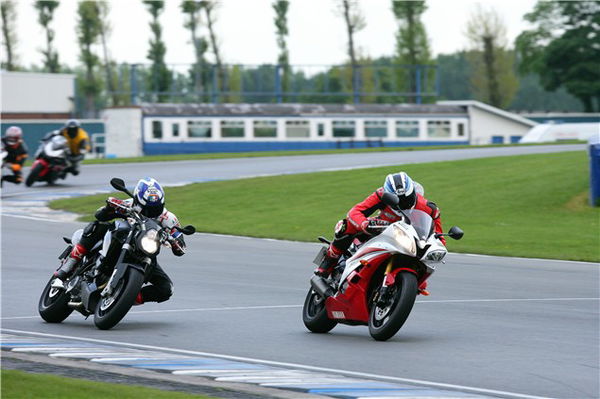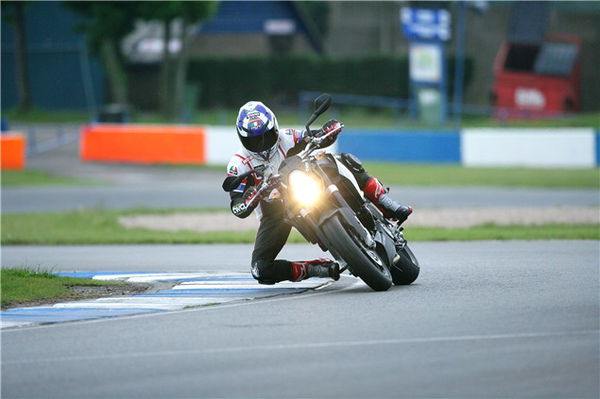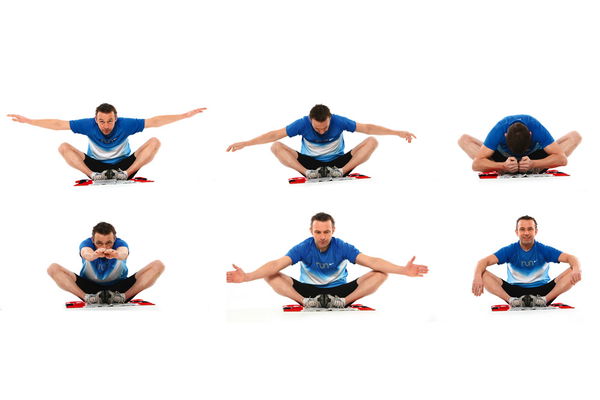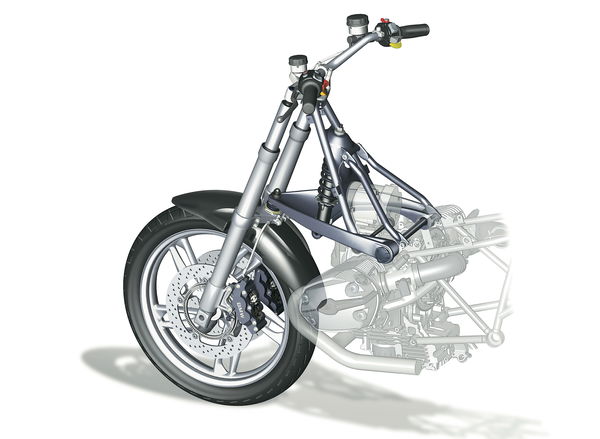Sharpen your mind: Be faster on track
Are you getting the most out of your track day, riding as fast as you can and pushing you own limits? Or have you slipped into the comfort zone?

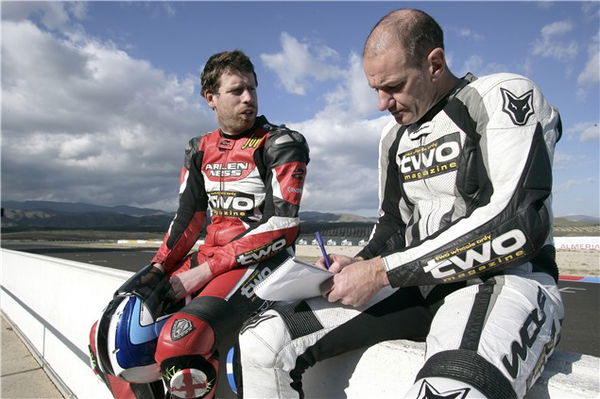
Recently I've noticed something about my riding on trackdays. I'll hit a certain pace but rather than trying to go any faster and risk a crash I'll simply circulate at a pace that is well within my boundaries. I've slipped into the Comfort Zone.
And I know I'm not alone. Like everyone else on a track day I have no interest in cart wheeling through a gravel trap. The embarrassment of being returned on the recovery truck is easily overcome, but broken bones and a bent bike are harder to laugh off. But the bottom line is that I want to go faster.
So what to do about it? With the fountain of knowledge that is Niall Mackenzie on hand I though I'd pick his brain about what was causing me to back off, what I was doing wrong and the best ways to break out of the comfort zone.
GET OUT OF THIS PLACE
First up, what exactly is a comfort zone? It is your body's natural defence mechanism kicking in and trying to prevent you from hurting yourself. We all have this system, it's a throw back from a time when things with big teeth (not Janet Street-Porter) used to think that a human was a tasty snack. The odd thing about this mechanism is that it can be trained and, in many ways, actually overcome.
Entering Redgate at 90mph is unlikely to make Niall flinch much. But my dear mum, on the other hand, would probably be experiencing a whole range of emotions at that point, calmness and serenity not being either of them. Niall has trained his body to be used to speed on a bike and knows exactly what to do. My mum, to the best of my knowledge, hasn't yet.
But even Niall's racer-brain needs the occasional recalibration. "The first test of a season always seemed a bit fast. I reckon it took me most of the first day to get dialled into the speed again." So now we have identified the problem, how to overcome it?
TRY A NEW POSITION
Having followed me for a session the first thing Niall spotted was my track position. Or lack of it. Braking for a corner my comfort zone had me riding with about three feet of clear track between my tyres and the outside of the circuit, something Niall demonstrated by overtaking me on this strip.
"This is so common at track days," Mackenzie said. "People are scared to get too close to the edge of the track at speed. But every inch of the circuit is vital to go fast, just look at GP riders who use it all, even the curbs. It can be scary at first but try a few laps at a slower pace using the entire track. The two feet or so that you gain by moving to the outside of the track makes the corner less of an acute angle. The wider the angle, the less you have to lean a bike over and the faster you can go around it. The easiest, quickest and safest, way of going faster is to use all of the track."
Which is easier said than done. When you are braking hard from 150mph that grass at the side of the track seems very close and it completely messes with my head, the first cause of the comfort zone in which I tend to sit. Niall advised slowing my pace down and concentrating on getting my positioning right, to acclimatise my brain to the fact that the edge of the track was closer before building up speed. Which worked. The difference a few feet at the entrance makes to the apex is very surprising. By riding as close as I could to the edge of the track the corners opened up and I was finding myself using less lean to get round, which highlighted another problem - position on the exit.
"For the same reasons as going into a corner, most riders won't use all the track on the exit. If you are running up to the kerb on the exit it means that you can open the throttle sooner or corner faster, you have a big safety margin, but build up to it slowly."
Getting my entrance and exit improved wasn't too hard, but the apex was a different matter. Think about what your knee is doing when you are at the apex. Is it on the track? If so then you have loads of track to spare. Niall's knee is over the curb, he has cut the corner so close that his body is over the inside of the bend. This is very hard technique to learn because, lets be honest here, cutting a corner that close is a bloody scary thing to do. Again Niall advises going slower to get used to the feeling but I admit this is the one thing I struggled with.
"Your instincts will tell you that you are too close to the kerb and you're abou to run off the track and crash," says Niall, "but practice it and the more natural it will feel."
NIALL'S WISDOM
"Most track riders get settled into a comfortable pace which I reckon is only 85% of their actual ability," Spuds sums up. "This is a big safety margin so don't be afraid to push it back a bit. The best way to improve is to get into a good rhythm and not rush things. Pick a corner and concentrate on getting it right."
"Get your braking marker, line and exit really nailed for that one corner then take it easier for the rest of the lap. Do this two or three times then when you are happy concentrate on the next corner."
"The main thing is to not beat yourself up if you don't get it right. Relax, concentrate and get a rhythm going. Once you get into a fast rhythm you will find things become instinctive and if you are riding smoothly the bike will feel better and your understanding of what is possible will increase. And that's when you'll start pushing the boundaries of your own comfort zone further back."

COMING THROUGH
On a track day it's common to see rider's bunched up because they aren't confident of overtaking a slower rider. The comfort zone is kicking in and riders are prepared to lap slower behind someone rather than risk an overtake.
"The best way to get past someone is to drive out of a corner faster and overtake them on a straight," says Niall. Set them up by dropping off slightly then run through the corner faster and use the extra acceleration. Sometimes it isn't possible to use this technique, either because they have a faster bike or they are strong out of corners, so you will have to out-brake them.
Again, plan which corner you want to do this on and pull up alongside on the brakes. Don't get too close to the other rider but allow them to see you are alongside and register you are overtaking. As long as the other rider knows you are there you won't scare him and he can alter his line or speed to compensate for you. What stops people overtaking is the fear that they will be off-line going into the next corner. Don't worry about this.
Because you are off-line you won't be as fast mid-corner, but as the other rider knows you are there you can get away with this. In racing it's called a block pass, but on a track day it is the safest way to overtake a slower rider.
THE RHYTHM METHOD
Something few riders think about is gear selection, but Niall insists you have to be more precise and know which gear you're in at any given point on the track for your brain to work as it should on the circuit.
"I always know 100% which gear I'm in," he says. "Racing, and fast track riding, is all about getting into a flow, a rhythm. Each corner is a system, a series of points that need to be joined. Brake at your marker, change down the correct number of gears, turn in, apex, drive out. Get this into a rhythm and you will be more confident and faster. If you are anticipating an action, whether it be braking, gear change or turn-in, it won't come as a surprise and your brain will expect it. Getting out of a comfort zone is all about preparing your body for the action. Suddenly braking later will make you tense up, so prepare yourself, relax and let your body know that all is okay and you will be able to get out of it."
Sports Psychologist - Andy Barton
"The key to over-coming mental blocks is to focus on the positive, not the negative aspects of a situation. The brain can't actually make a representation of a negative, it can only make a positive one. For example if you tell a golfer not to think about hitting their tee shot into the woods, the brain will instantly image hitting a ball into the woods.
So you need to give your brain a positive scenario to focus on. Rather than thinking about what will happen if you miss the corner, crash or do something bad, focus on the good aspects. Think 'if I brake later I will go around the corner faster' rather than 'if I brake later I could run into the gravel.' The brain can only focus on one thought at a time. If you are thinking a positive then you can't think about a negative.
Past experiences can also hamper performance. If someone has crashed before, or even has watched a crash on TV, then this can form a phobia. This can also be overcome by thinking positive. The brain is protecting the body from what it sees as a threat, and you need to re-educate it. Change the language you use to think about your performance and always concentrate on positives rather than negatives ."
Andy runs The Sporting Mind at www.thesportingmind.com

